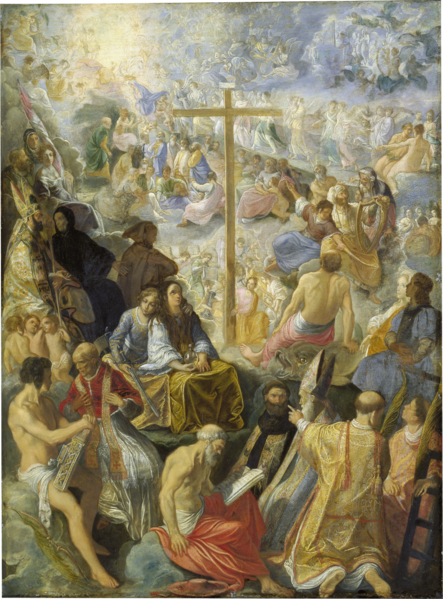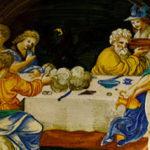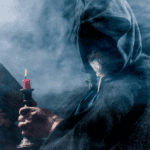 Mysteries
Mysteries  Mysteries
Mysteries  History
History 10 Surprising Stories About the Texas Rangers
 Humans
Humans 10 Philosophers Who Were Driven Mad by Their Own Theories
 Miscellaneous
Miscellaneous 10 Video-Game-Worthy Weapons and Armors from History
 Weird Stuff
Weird Stuff 10 Psychics Who Accurately Predicted Wartime Events
 The Arts
The Arts 10 Pieces of Art Inspired by a Broken Heart
 Health
Health 10 Science Fiction-Sounding New Medical Treatments
 History
History 10 Surprising Facts About the Father of Submarine Warfare
 Space
Space Ten Astonishing New Insights into Alien Worlds
 Weird Stuff
Weird Stuff 10 Bizarre Summer Solstice Rituals Still Practiced Today
 Mysteries
Mysteries Top 10 Haunting Facts About the Ghost Ship MV Alta
 History
History 10 Surprising Stories About the Texas Rangers
 Humans
Humans 10 Philosophers Who Were Driven Mad by Their Own Theories
Who's Behind Listverse?

Jamie Frater
Head Editor
Jamie founded Listverse due to an insatiable desire to share fascinating, obscure, and bizarre facts. He has been a guest speaker on numerous national radio and television stations and is a five time published author.
More About Us Miscellaneous
Miscellaneous 10 Video-Game-Worthy Weapons and Armors from History
 Weird Stuff
Weird Stuff 10 Psychics Who Accurately Predicted Wartime Events
 The Arts
The Arts 10 Pieces of Art Inspired by a Broken Heart
 Health
Health 10 Science Fiction-Sounding New Medical Treatments
 History
History 10 Surprising Facts About the Father of Submarine Warfare
 Space
Space Ten Astonishing New Insights into Alien Worlds
 Weird Stuff
Weird Stuff 10 Bizarre Summer Solstice Rituals Still Practiced Today
10 Mysterious (Sometimes Gross) New Facts about Ancient Cults
Say the word “cult,” and you might imagine people holed up in a compound somewhere, convinced that the end is nigh. But in ancient times, cults were taken more seriously and often involved entire populations. This list looks at previously unseen discoveries that added even more mystery or gore to what we already know. From the correct etiquette for boiling a head to a naughty story written by a priest, here are ten finer details about ancient cults you probably didn’t know!
Related: 10 Dark and Esoteric Occult Practices From History
10 A Rare True Cross Scroll

The “Cult of The Cross” describes the rituals and beliefs surrounding the True Cross (the cross on which Jesus died). In 2021, an extremely rare artifact was discovered. Unfortunately, it was not a splinter from the True Cross, but it was a parchment closely linked to this chapter of Christianity.
Researchers have always known about the 500-year-old scroll. However, it kept disappearing into the hands of private collectors, meaning it could never be examined. When it was recently rediscovered, the artifact revealed a smorgasbord of exquisite illustrations that provided more insights into the Cult of the Cross. But two more things stunned the researchers.
First, such prayer rolls, which were constantly unfurled, touched, and kissed by worshipers, rarely survive to the present day. For one of them to remain intact 500 years later is remarkable in itself. Then there’s the intimate link with the lore of the True Cross. The prayer roll was likely created at Bromholm Priory in Norfolk. This place once attracted pilgrims because the priory’s own cross was said to contain a fragment of the True Cross. Called the Rood of Bromholm, the cross is now missing, but it appears as a crucifixion painting in the scroll.[1]
9 A Cult Buried with Their Pharaoh
In 2021, archaeologists were digging at Saqqara, an ancient Egyptian burial ground, when they found a temple. The stone temple had three warehouses lined up on one side. These mud-brick storage areas and nearby shafts contained items that provided insights into a cult that worshiped a royal couple.
The temple was a funerary building constructed in honor of Queen Nearit. The building was next to the pyramid of her spouse, Pharaoh Teti, who ruled Egypt roughly between 2323 BC and 2291 BC. The shafts were also near the pyramid and contained the bodies of those who belonged to the cult. It would appear that they desired to stay close to the pharaoh, even in death.
The cult seemed to have flourished for over 1,000 years. Some of the items found inside the burial shafts provided clues about what mattered to them. An incredible papyrus, measuring 13 feet long (4 meters), contained a chapter from the “Book of the Dead,” a guide on how to navigate the underworld. Other objects also showed that people named their children after royal family members and that the gods Osiris and Anubis were important to them.[2]
8 A Religion Older Than the Incas
We are still trying to piece together everything about the Incas, a complex society that once ruled the pre-Columbian Americas, from Columbia to Chile. Long before the Incas, however, there was an even more mysterious and elaborate society. This empire was the Tiwanaku state, and very little is known about them.
In 2013, researchers explored Khoa Reef in Bolivia’s Lake Titicaca. The reef lies near the Island of the Sun, a pilgrimage site for the Incas, who adorned the island with offerings and ceremonial buildings. However, as artifacts older than the Incas were found near the reef, it recovered a big piece of Tiwanaku culture. In short, they practiced a mystery religion that pre-dates the Incas by 500 years.
Besides beating the Incas to the lake, the Tiwanaku people also designed their offerings to be submerged in the lake. This clue came from anchors found near the items. The offerings included incense burners shaped like pumas, gold ornaments, shell and stone trinkets, and young llama remains. All this suggested that the Tiwanaku performed sophisticated rituals from boats and that the puma and the god Viracocha (found on gold medallions) were also important religious symbols to them.[3]
7 Ramses II Had a Ram Cult
Recently, excavations at the ancient Egyptian city Abydos revealed a gruesome sight. Long ago, a single ritual had sacrificed 1,200 rams, and their heads were left behind in honor of Pharaoh Ramses the Great.
The ram heads were discovered in a storage area and needless to say, it’s a very unusual find. Some of the skulls were even wrapped in cloth, and one animal still had a bell around its neck. Not being able to resist, someone jostled the item, and amazingly, despite having been quiet for 2,000 years, it rang. The rare artifact might’ve been created especially for the ritual because it was decorated with symbols representing gods.
But at the end of the day, the discovery points to a ram or Aries cult that centered itself around Ramses II. One that potentially worshiped the popular king for 1,000 years after he died. Ramses II took the throne in 1279 BC and maintained power for nearly 70 years. He was known for so many great things that nine other pharaohs chose to call themselves Ramses too.[4]
6 A Mysterious Skull Cult
Göbekli Tepe is a famous ancient site in Turkey. Built roughly 11,000 years ago, the builders were known for producing intricate carvings, tall pillars, and large stone rings. But they also left a few mysteries behind. There are no graves and no evidence that people even lived there, despite the fact that the site kind of looks like a town.
That doesn’t mean that human remains weren’t found. Over the years, 691 human bone fragments surfaced. However, seven skull pieces from three adults had experts flummoxed. First, they were found in a backfill mixture inside a stone structure. Nobody can explain why the skull bones ended up there. Deliberate carvings and drill marks on the fragments also pointed to a skull cult at Göbekli Tepe, but the markings gave no clue as to the purpose of such a cult.
But here’s the weirdest thing. The people of Göbekli Tepe created stunning structures and art. Compared to that, the skulls were crudely carved. Perhaps the deep grooves allowed decorations to be added—or the skulls were deliberately disfigured to punish the dead individuals.[5]
5 The Temple That Became a Tomb
Spain’s Carmona necropolis is packed with burials from the 1st to the 2nd century AD. One of its most famous structures is the Elephant’s Tomb (someone found an elephant statue inside). When researchers first looked at the grave, it became clear that the burial wasn’t a normal six-foot-under affair. Instead, the building’s elaborate design hinted at another purpose besides being a tomb. Eventually, Spanish archaeologists discovered strong evidence that a cult once used the structure. Indeed, the “tomb” had all the hallmarks of a Mithraeum, a temple dedicated to the Roman god Mithras.
For example, during the spring and fall equinoxes, sunlight would’ve entered the window so that the center of the chamber filled with light, possibly illuminating a now-missing statue of the god. Two of the cult’s most important constellations, Scorpio and Taurus, also lined up with the building. Other features it shared with known Mithraeums included a fountain and a room divided into three sections.
Experts now believe that, at some point, the devotees started to lose interest in the temple. Once the Mithraeum was abandoned by the cult, the structure was repurposed as a tomb.[6]
4 Inca Worshipers Weren’t Equal
During the early 15th century, the Inca developed an elaborate solar cult to worship the Sun. Many of their rituals and beliefs have surfaced in recent years, but in the late 1990s, researchers uncovered something that hadn’t been recorded before—something that wasn’t very flattering. In short, not every devotee of the cult was considered equal during worship.
It started with the discovery of large stone pillars. Archaeologists have always known that the Inca had such ritual pillars, thanks to records indicating that they once existed in the Inca capital of Cusco. These pillars recorded the Sun’s location near the horizon during the June and December solstices, which were important days on the cult’s calendar.
While surveying the Island of the Sun, an Inca ritual hotspot in Lake Titicaca, researchers found the first pair of these solar pillars. They also discovered a platform nearby. All research showed that both features were designed to separate the elite from the lower classes during rituals. While the king and other ranked individuals worshiped inside the sanctuary, the rest gathered on the platform to observe the mesmerizing spectacle of the Sun setting directly over their rulers and the pillars. Such a sight would’ve cemented the elite’s power even more.[7]
3 A Naughty Story

In 2012, experts deciphered a curious ancient papyrus. Written in an old form of Egyptian called Demotic, the text was not your typical story that praised a pharaoh or a god. Nope. This was a story about sex. Researchers believe that the author might even have been a priest. However, this wasn’t a case of a perverted priest writing erotica in his spare time. Instead, the papyrus might have served a very important purpose.
The fictional story includes singing, feasting, drinking, and ritual sex. All these activities are happening in the name of the Egyptian goddess Mut as acts of worship, not revelry. In other words, the tale wasn’t written to entertain anyone. Instead, the discovery suggests that such “cult fiction” existed to ease the discussion around controversial sex rituals and other contentious topics among priests.[8]
2 A Cult the Size of Poland
In the 1960s, a survey team noticed a couple of rectangular stone structures in north-western Saudi Arabia. At the time, nobody realized the scope and cult-related significance of the buildings, which were later named “mustalil.” It wasn’t until more recently that tantalizing facts about the ruins began to emerge.
About 1,600 mustalil were found sprinkled across 116,000 square miles (300,000 square kilometers). Some had so many stones that they weighed more than the Eiffel Tower. Others were the length of four football fields and as wide as two. The monumental structures were all 7,000 years old, which made them older than the Giza pyramids and Stonehenge.
Their construction also showed the builders understood local materials and engineering and had a widespread belief system that demanded sacrifices. Stuffed inside small chambers of the mustalil were countless animal skulls. Since no other body parts were found, this suggested that the sacrifices happened elsewhere. Ritual artifacts found at the site also support the idea that this mysterious cult once spanned an area the size of Poland.[9]
1 How to Boil a Head
In 2019, archaeologists were doing field work along the coast of the Red Sea. The team was excavating the ancient Egyptian port of Berenike when they discovered the remains of a temple. The two-room shrine had an Egyptian design and decorations—but the people who once worshiped there were not Egyptians. They belonged to a mysterious semi-nomadic group called the Blemmyes.
Almost nothing is known about the Blemmyes, so it was interesting to note that the temple suggested that they had adopted Egyptian beliefs. In this case, the building’s purpose was to worship the Egyptian falcon-headed god Khonsu. The discovery also revealed the cult’s etiquette for boiling heads.
An inscription found inside the temple read, “It is improper to boil a head in here.” Since many decapitated falcon skeletons were found inside, it’s safe to assume that the cult did not hack off human heads but, instead, those of birds. The rule also implied that worshipers had to boil falcons before offering them to Khonsu. Perhaps the heads were cooked, too, only it was forbidden to do so within the sacred walls of the temple.[10]








